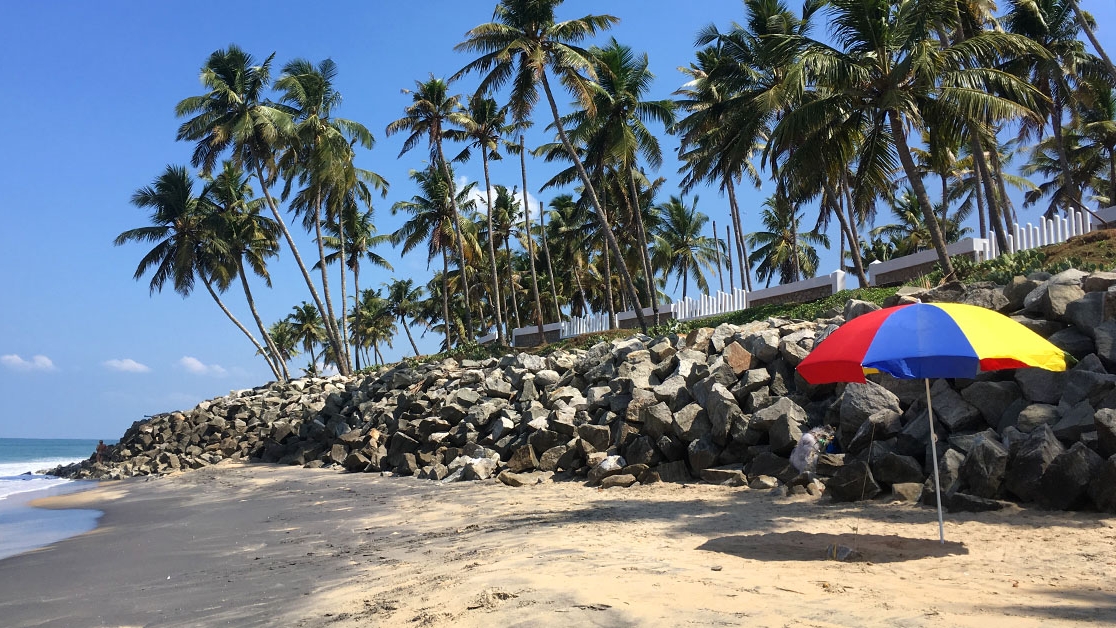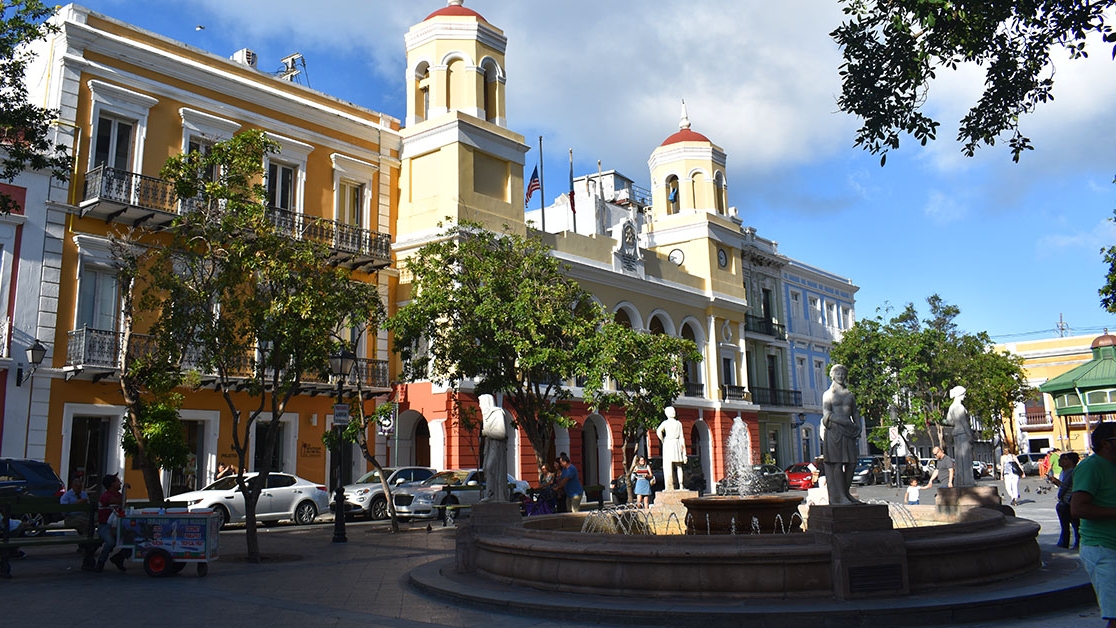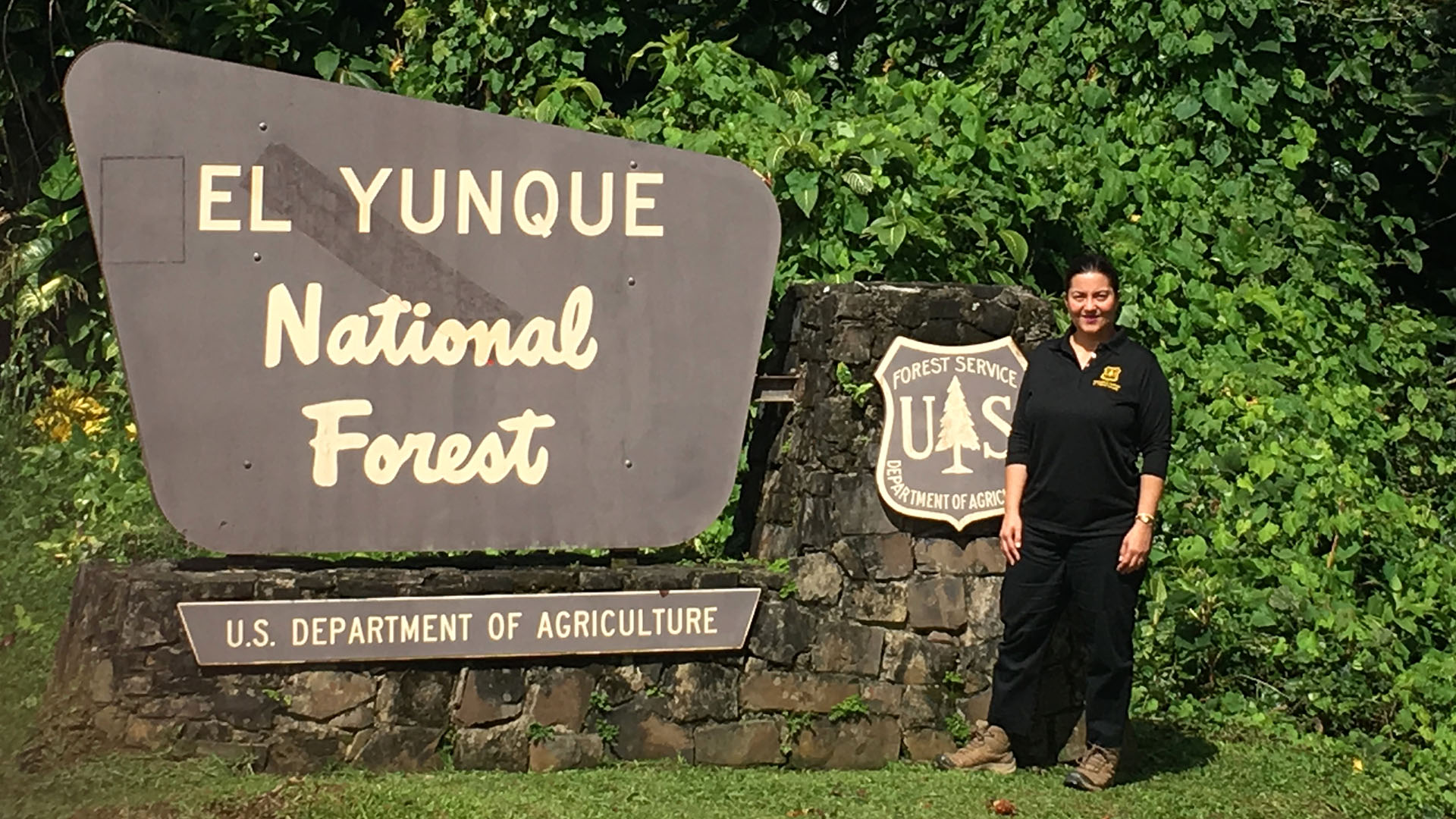Restoring Pride in Puerto Rico

Grizelle Gonzalez, a researcher at El Yunque National Forest
Story and photos by Rebecca Holland
Rebecca Holland is a freelance travel and food writer based in Chicago. You can find her on Instagram.
A trip to El Yunque National Forest can teach tourists about resiliency and the importance of preservation.
Two things happened as I drove out of San Juan on Puerto Rico Highway 26. One, the mountains started to show in the distance as fog made way for early morning sun. Their green hills covered with palm trees and bright flowers were a welcome change from billboards and rows of buildings. Two, there were traffic issues due to broken street lights. Without lights working at major intersections, drivers hesitantly followed four-way stop rules, hoping others on the road got the same idea. Once on the highway, the road was in good shape, but fallen trees on both sides increased — left from Hurricanes Maria and Irma in 2017.
The debris was surprising to see a full six months after the storms, and a contrast to San Juan, where visitors would never guess that Maria, the worst hurricane in Puerto Rico’s history, wiped out much of the island's power. San Juan was crowded with tourists, who filled the city’s hotels and vacation rentals almost to capacity during the last week of February, dined at bustling restaurants and danced into the night at Plaza de Mercado alongside residents who only talked about the disaster when asked. The colorful streets of Old San Juan were pristine, the beaches were clean and every attraction, museum and hotel was open for business. I hadn’t been sure what to expect, but everything seemed just as it was when I traveled to San Juan a year before the hurricanes.

Old San Juan as seen from inside Castillo San Cristobal, the largest Spanish fort built in the Americas.

Tourists can visit La Coca Falls, one of the sights accessible as El Yunque recovers.
Lush trees lined the road as we neared El Yunque, the only tropical rainforest in the U.S. National Forest System. Puerto Rico has more than 1 billion trees, many of them concentrated in the 28,000-acre rainforest. After Maria, nearly all of the forest’s trees were stripped of their leaves.
“There was no green,” said Grizelle Gonzalez, a research ecologist and project leader working with the National Forest Service.
She’s worked at the park for more than 20 years and had never seen anything like it. The forest was so bare it made her cry. But, within four or five days she said sprouts started to show, and within a few weeks, leaves were growing on the trees.
“It was an interesting connection between nature and people,” she said. “People could go in their backyard and see trees and vegetation recovering, and then they could think, ‘we can recover, too.’”
To tourists, the trees could easily look fully regrown. Gonzalez says that the lower the elevation, the faster the tree recovery. Higher in the mountains, trees are still mostly bare. Looking up through a zoomed-in camera lens, it was obvious she was right.
Gonzalez is on a mission to inform people about how recovery works.
“First of all, it’s important people understand the difference between defoliation and deforestation,” she said.
These trees have been defoliated, which is when trees are stripped of leaves. Deforestation is when entire trees are removed so the land can be used for something else.
A natural process kicks in when defoliation occurs. Forests have adapted to these events, and the trees store nutrients in their trunks, which then get released slowly throughout recovery.
Second, monitoring long-term recovery gives a better picture of how bad the damage actually is. For example, during Hurricane Hugo in 1989, 10 percent of the trees died immediately. Fifteen years later, some still have not regrown. So far with Hurricane Maria, the mortality rate of trees is 20 to 30 percent more than it was with Hurricane Hugo, and only time will tell what will happen in the years to come.
Puerto Rico has received a lot of rain since the hurricane, which helps. After Hugo, there was a drought, which decelerated recovery, but a large amount of rain since Maria has helped trees recover faster.
“This time, at least we are lucky there,” Gonzalez said.

Roads are being rebuilt as quickly as possible.

Landslides are one reason why more areas of El Yunque aren't open yet.
Although in many areas visitors will be surrounded by greenery, Gonzalez points out that the forest canopy is still open.
“The low end for a more full recovery is five years,” she said. The high end is 50 to 100 years. “We have a lot of slow-growing, endemic species here.”
Roads throughout the forest are closed due to landslides (Mina Falls, for example, is inaccessible due to dozens of them), but there are areas open for tourists, and in some cases, they’re more spectacular than ever. La Coca Falls has benefited from the rain and gushes beautifully down the cliff side. Tourists can drive along Road 191 to the falls viewpoint, a scenic drive worth the short trip from San Juan. Angelito Trail, a 0.7-mile walking trail, is also open. While not a strenuous hike with sweeping views like some of the other paths, it does end at a picturesque stream where you can relax with a book and picnic on the banks, or hop in for a refreshing dip.
Gonzalez and others are trying to see the positive side in the aftermath of disaster. According to the Army Corps of Engineers, there were 3.6 million cubic feet of debris from Hurricane Maria, and 60 percent of that was vegetation. Debris is normally turned into mulch, but now people are looking into more valuable uses.
“It could be used for cultural and economic opportunities, like milling, so we’re trying to rescue and manage our resources,” Gonzalez said. “We’re trying to turn a negative into a positive.”
She said it would take more than a year for the forest to feel normal for tourists, but she hopes they still visit in the meantime.
“Everyone is working as fast and as hard as they can,” she said. “And so far, we’ve given out over 100 special use permits for tours to come back.”
El Yunque is the second most popular tourist attraction in Puerto Rico, with Old San Juan coming in first. The rainforest is a major draw for tour groups, day trips and cruises. Forest Supervisor Sharon Wallace says tourism is $400 million of Puerto Rico’s economy, and El Yunque is 25 percent of that.
“So it’s very important in terms of the local economy, and in supporting the small and local businesses around the park,” she said.

La Coca Falls

An avocado, banana, and peanut butter smoothie (left) and a mixed berry smoothie at 18 Degrees Juice Bar.
The forest service has been encouraging entrepreneurs to start new endeavors around the park, trusting tourists will come back. I saw signs for tours to El Yunque operating out of San Juan, and just outside the park exit, 18 Degree Juice Bar served one of the best smoothies I’ve ever had. The owner told me business has been slow but is picking up, and he was optimistic it would continue to do so.
Tourists who want to help can visit Puerto Rico and frequent local hotels, restaurants and shops, and they can volunteer at El Yunque National Forest.
Wallace is putting together programs for tourists to help with painting, debris removal, conservation education, providing information to the public and more.
“Stay tuned to our website and Twitter because information is changing all the time, and there are new opportunities and new areas open every day,” she said.
Wallace and Gonzalez hope visitors understand that the forest service is doing their best. El Yunque will recover, but it could take years, and no one knows what would happen if another hurricane were to strike. In the meantime, I was inspired to see greenery fill what was barren just months before, and passionate people work for the forest. Their efforts are a lesson in rehabilitation and how we can work with, but never control nature. The forest itself is unlike anything else you can find in the United States and visiting it, even in its limited state, is sure to be a highlight of your time in Puerto Rico.

The cemetery in Old San Juan can be seen from the walking trail on the edge of the city.
Related
Read more stories about Puerto Rico.
- Road Trips from San Juan, Puerto Rico
- 24 Hours in San Juan, Puerto Rico
- Restoring Pride in Puerto Rico



